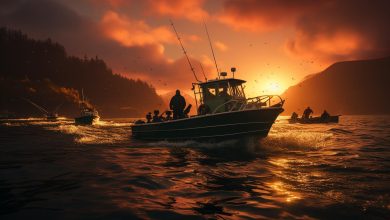Nymphing Techniques Strategies For Targeting Trout Beneath The Surface
Are you tired of casting your line over and over again without any luck? Do you want to increase your chances of catching trout? Then it’s time to learn about nymphing techniques.
Nymphing is a way to target fish beneath the surface, where they are often feeding on aquatic insects. With the right knowledge and equipment, you can master this technique and improve your fishing skills.
To start, it’s important to understand the behavior of both trout and aquatic insects. Trout are known for their selective feeding habits, meaning they only eat certain types of insects at certain times. By learning about these patterns, you can choose the best flies and presentation techniques to mimic their natural prey.
Additionally, understanding the life cycle of aquatic insects will help you determine when and where they are most likely to be present in the water column. With this knowledge in mind, you’ll be better equipped to choose the right nymphing techniques for each situation.
Understanding the Behavior of Trout and Aquatic Insects
Understanding how fish and bugs interact is key to catching more fish when they’re feeding underwater! Trout are opportunistic feeders, meaning they’ll eat just about anything that looks like food. However, their feeding patterns change depending on the time of day, weather conditions, and water temperature.
To effectively target trout beneath the surface, it’s important to understand these patterns and adjust your nymphing techniques accordingly.
Aquatic insect life cycles also play a crucial role in trout behavior. Nymphs make up a large portion of a trout’s diet, so knowing what insects are present in the water you’re fishing can help you choose the right flies to imitate them.
By observing the bugs that are hatching or crawling along the bottom of the riverbed, you can determine which stage of their life cycle trout are most likely feeding on. This knowledge will allow you to select flies that closely resemble those insects and increase your chances of hooking into a hungry fish.
Now that you have an understanding of how trout behave and what insects they’re feeding on, let’s dive into mastering nymphing techniques!
Mastering Nymphing Techniques
When it comes to mastering nymphing techniques, there are three key points that you need to focus on:
- Strike detection: You’ll need to keep a close eye on your line for any sudden movements or stops to effectively detect strikes.
- Drift control: Controlling the drift of your nymph is crucial in presenting it as naturally as possible to the trout, so pay attention to the speed and direction of your line.
- Setting the hook: When you do get a strike, make sure to set the hook firmly and quickly to ensure a successful catch.
By mastering these techniques, you’ll be well on your way to becoming a successful nymph angler.
Strike Detection
Spotting when a fish bites can be tricky, but it’s essential to master if you want to catch more fish. Here are five tips for strike detection that will help you improve your nymphing game:
-
Watch for visual cues such as the tip of your fly line twitching or suddenly stopping.
-
Keep an eye on the indicator – any sudden movement could indicate a fish has taken your fly.
-
Pay attention to changes in tension – if you feel a sudden pull or resistance, set the hook!
-
Be patient and wait for the second tug – sometimes a fish will take the fly and then let it go before fully committing.
-
Follow through with your hookset – make sure to keep tension on the line after setting the hook.
Remember, strike detection takes practice and patience. Don’t get discouraged if you miss a few bites at first. With time and experience, you’ll become better at spotting those subtle signs that indicate a trout has taken your fly.
Now that you know how to spot when a fish bites, let’s move on to drift control. By mastering both strike detection and drift control, you’ll be well on your way to becoming a successful nymph angler.
Drift Control
It’s all about getting that perfect drift – the key to catching more fish with your fly.
To achieve this, indicator placement and mending techniques are crucial.
The first step is to choose the right size and type of indicator for the water you’re fishing. You want it to be visible without spooking the fish. Place it on your leader at a distance that will allow you to detect any movement, but not too close that it affects the natural drift of your fly.
Once you have your indicator in place, focus on controlling the drift of your fly. This means mending your line as necessary to keep the fly in a natural presentation. Mend upstream or downstream depending on current speed and direction, making sure not to create any drag on the fly.
A successful drift requires constant adjustments as conditions change, so stay vigilant and responsive to changing currents.
With proper control over your drift, you’ll increase your chances of hooking up with trout beneath the surface.
And speaking of hooking up…
Setting the Hook
You’re on the edge of your seat, heart racing as you wait for that moment when the fish takes the bait and you set the hook. It’s a crucial step in nymphing and requires precision and timing tactics to execute successfully. Here are some tips to help you improve your hook setting skills:
-
Timing tactics: The key to setting the hook is waiting until you feel resistance before pulling back on your rod. If you try too early, you risk pulling the fly out of the trout’s mouth. However, if you wait too long, the fish may spit out the fly before you even realize it has taken it. Practice feeling for that subtle change in tension and be patient.
-
Hook setting angles: The angle at which you set your hook can also affect its success rate. Ideally, you want to pull back with a smooth and swift motion parallel to the water surface. This angle helps ensure that both barbs of your hook pierce into the trout’s jaw, increasing your chances of a successful catch.
-
Be mindful of these timing tactics and hook setting angles as they can make all the difference between landing a trophy fish or going home empty-handed.
As important as it is to master setting hooks properly, choosing the right equipment can also play an essential role in nymphing success.
Choosing the Right Equipment
Picking the correct gear is vital for successfully catching fish using this method, and it’s important to choose equipment that suits your individual needs. When selecting your gear, consider the type of water you’ll be fishing in and the size of the fish you’re targeting.
For instance, if you’re fishing in a small stream with small trout, a lightweight rod with a sensitive tip and light tippet may be best. On the other hand, if you’re fishing in larger rivers with bigger trout, a heavier rod with more backbone may be necessary.
In addition to equipment selection, gear maintenance is also crucial. Make sure your reel is working properly and that your line is clean and free from any nicks or abrasions that could cause it to break. Check your fly box before heading out to ensure you have all the patterns you need for the day’s fishing.
With proper equipment selection and maintenance, you’ll be well on your way to catching more fish using nymphing techniques.
Now that you’ve got your gear sorted out, it’s time to move on to identifying the best nymphing locations. Keep in mind that successful nymphing requires finding areas where trout are likely feeding beneath the surface of the water, so look for spots where there’s plenty of cover or structure for them to hide behind as they wait for their next meal.
Identifying the Best Nymphing Locations
To up your game and reel in more fish, it’s time to scope out the prime feeding spots where these aquatic creatures are lurking amongst cover and structure. Here are a few key factors to consider when identifying the best nymphing locations:
-
Stream flow: Pay attention to how fast or slow the water is moving. Trout tend to congregate in areas where there is a moderate current.
-
Bottom structure: Look for drop-offs, riffles, and pockets of calm water. These provide ideal habitat for trout.
-
Water temperature: Trout prefer cooler water, so focus on areas where the temperature is below 65 degrees Fahrenheit.
-
Light conditions: Overcast days can be great for nymphing because it makes it harder for trout to see you. However, if it’s sunny out, look for shaded areas where trout might be seeking refuge.
By taking these factors into account, you’ll have a better chance of finding those elusive trout.
Once you’ve found your spot, it’s time to move on to advanced nymphing techniques that’ll help you catch even more fish.
Advanced Nymphing Techniques
If you’re ready to take your fly fishing skills to the next level, mastering advanced nymphing techniques will help you target trout in deep water and increase your chances of success.
Euro style nymphing is a highly effective method for getting your flies down quickly and keeping them in the strike zone for longer periods of time. This technique involves using a long, light rod and heavy leader to achieve a tight line presentation that allows you to feel every bump and take from the fish.
Another advanced nymphing technique is dry/dropper variations. This approach involves using a buoyant dry fly as an indicator with one or more subsurface dropper flies tied below it. This allows you to cover two different depths at once, increasing your chances of finding feeding fish. Experiment with different combinations of dry flies and droppers until you find what works best for the conditions and the fish in your area.
With these advanced techniques in your arsenal, you’ll be able to target trout in even the most challenging conditions and increase your chances of landing that trophy fish.
Conclusion
Congratulations! You’re now well-equipped with the knowledge and techniques needed to master nymphing. By understanding the behavior of trout and aquatic insects, you can optimize your approach for a successful catch.
With practice, you’ll be able to choose the right equipment and identify the best locations for nymphing. Remember to stay patient, as this technique requires a bit more time and precision than others.
But once you get it down pat, you’ll feel like a pro angler. Don’t forget about advanced nymphing techniques either – these will take your skills to the next level.
With persistence and dedication, you’ll be able to outsmart even the most elusive trout beneath the surface. So grab your gear and hit the water – happy fishing!


